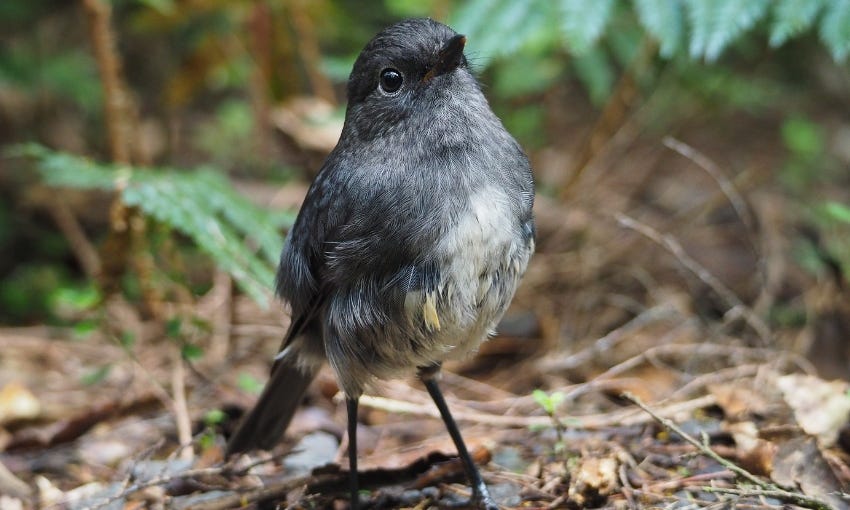Three easy ways to ease off the fast fashion accelerator
More than 200,000 tonnes of textile waste ends up in New Zealand landfills every year.
Kia ora, welcome to Future Proof! I’m Ellen, thanks so much for joining me this week.
Image credit: Designer Wardrobe.
In 2022, fast fashion retailer Shein produced 49 billion garments. That’s six pieces for every person on the planet. Such frenzied production of low-quality attire has an enormous environmental impact – think of all the water, energy and raw materials needed to make these clothes. And what happens once it’s been worn a couple of times? It gets chucked. Every second, a truckload of clothes is burnt or buried in landfill.
Last week the Australian Fashion Council launched Seamless, a voluntary product stewardship scheme which imposes a 4 cent levy on each garment. Funds raised from the levy will be used to tackle the hundreds of thousands of tonnes of textile waste sent to landfill every year. But so far, only six major retailers have signed up to Seamless, falling short of the 60% industry participation needed to raise $36 million needed for the scheme. The Environment Minister, Tanya Pilbersek, told the fashion industry it has 12 months to sign up or face regulation. "That is a drop dead date. No excuses, no extensions," Plibersek said, according to the ABC. "I will impose a system and I will set the levy."
Here in Aotearoa, textile waste is a huge – and fast-growing – problem too, with an estimated 220,000 tonnes ending up in landfill each year. Jacinta FitzGerald, director of Mindful Fashion, told Checkpoint that New Zealanders throw out about 8kg of clothing waste per person each year – equivalent to one coat, five pairs of pants, five T-shirts, a pair of shoes and a bag of socks. The New Zealand fashion industry is piloting its own, industry-designed programme, Textile Product Stewardship Aotearoa. But as consumers, we have a role to play too. Forgoing fast fashion and microtrends in favour of a more eco-friendly wardrobe doesn’t have to be pricey. Here are three simple ways to boost the sustainability of your fits.
Go secondhand
Sixty percent of New Zealand shoppers are opting for pre-loved clothing, according to a survey of 500 people commissioned by Designer Wardrobe. CEO and co-founder Aidan Bartlett says the survey results showcase the growing popularity of secondhand clothing, with shoppers motivated to thrift by affordability, style and sustainability. You don’t have to go digging through bargain bins, either (although that’s totally cool if that’s your jam!), thanks to the rise of digital-first resale platforms. Same goes for renting a fancy gown, with plenty of dress rental services on offer.
Get your mend on
All you need to give your worn, holey clothes a second life is “needle, thread and will”, according to clothing upcycler Lindsay Rose Medoff, interviewed in Nylon magazine. It can also be a way to add individuality and creativity in an age characterised by mass-produced fashion, through the practice of “visible mending”. And if you’re not confident with a needle and thread? Check out your local repair cafe for help.
Wash less
Extend the life of your clothes by washing them less. Washing clothes can cause them to rip, warp, shrink and lose colour over time. A growing number of people are rethinking how often they pop on a load of laundry, according to the BBC – including designer Stella McCartney. “If you don't absolutely have to clean anything, don't clean it,” she told The Guardian in 2019. So how often should you wash clothes? As for many things in life, when in doubt, trust your nose.
The easy way to stay across the news
The Bulletin is The Spinoff's morning news email. Anna Rawhiti-Connell and Catherine McGregor curate the best and most essential news and journalism and email it free to you each weekday morning. All you need to do is add your email address below or click here to subscribe. Doomscroll no more and join over 38,000 New Zealanders who start their day with The Bulletin.
Mandatory packaging design standards announced for Aus
Textiles weren’t the only wastestream in the crosshairs across the ditch last week, as the Australian Government announced strict new rules for plastic packaging, focused on “designing out waste at the start” and making industry responsible for the packaging they place on the market. This regulation is the result of the failure of industry to meet voluntary standards.
In homegrown waste news, two clean-up efforts at opposite ends of the country. In the far south, 16 volunteers are heading to Rakiura to clean up remote beaches next month. The South Coast Charitable Trust, who organised the trip, have removed 72 tonnes of rubbish from Rakiura and Fiordland beaches over the last 20-odd years. And up north in Tāmaki Makarau, the E-Tu Rakau Waste Waka is turning the simple act of picking up litter into a party, with speakers blasting beats.
Books on climate and fungi for your reading pile
We’re still at the starting blocks when it comes to climate action, says climate researcher James Renwick. In his new book, Under the Weather: A Future Forecast for New Zealand, Renwick outlines where we’re at with climate change, and what we should do to wind back emissions. The Spinoff has published an excerpt of the book, from the ‘Local action’ chapter. In other enviro book news, Liv Sisson has written a fabulous guide to New Zealand’s fungi. In this excerpt, she discusses how fungi can help us fight antibiotic resistance, and research into traditional Māori use of native magic mushrooms.
Calls for better cat management grow louder
The impetus and social licence for a Cat Management Act continues to grow, with environmental organisations, animal welfare groups and government agencies presenting on the topic at a recent Environment Select Committee hearing. The Predator Free NZ Trust has compiled a useful summary of what the different presenting parties said, but across the board, there are twin desires to keep cats safe at home and protect native wildlife. More on cats in this edition of Future Proof from last year, and see recent reporting from TVNZ’s Sunday on feral cats.
Our members make the difference
The support of our members ensures we can continue to employ and commission diverse voices covering stories from a range of perspectives and make them freely available to all. From Spinoff stalwarts Toby Manhire and Alex Casey to emerging talents like Charlotte Muru-Lanning and Shanti Mathias, our journalists and contributors do valuable work that is only possible with the support of readers like you. If you can, support the team and donate today.
More stories:
Last week I mentioned a Reuters investigation that found rich countries were using the guise of climate finance to bankroll gelato shops and airport expansions – i.e. very much not climate projects. Turns out, New Zealand is not immune, with Stuff’s Olivia Wannan discovering that MFAT funded projects to establish and intensify dairy and beef farming in Fiji, Myanmar, Laos, Sri Lanka and Uruguay under the “climate finance” banner.
Warming seas threaten mahinga kai, or food gathering, practised by iwi and hapū for generations, Tess McClure writes for The Guardian.
Haere mai, El Niño – what does this mean for weather patterns in New Zealand?
Zoo Miami is building a new enclosure for Paora the kiwi, after the Association of Zoos and Aquariums met with DOC to discuss proper kiwi treatment.
The director of Netflix’s Don’t Look Up has launched a content studio to fight back against climate disinformation with satirical articles, videos, memes, and direct action.
Newsroom’s Marc Daalder analyses the National party’s just-released agricultural emissions policy, which would see any price on agricultural emissions pushed out to 2030.
Kōkako have turned up in the remote Waitaanga Conservation Area in Taranaki for the first time in 25 years, surprising DOC staff.
A neat interactive story documenting an expedition to survey the tallest known tree in the Amazon rainforest, measuring 88.5m tall. That’s approaching half the height of Auckland’s Sky Tower, and just pips New Zealand’s tallest tree (an introduced mountain ash eucalyptus in Orokonui Ecosanctuary near Dunedin, 82.25m).
To finish this issue, more good bird news. Toutouwai are making a comeback in Abel Tasman National Park, with a 2022 acoustic recording detecting the teeny birds at double the number of sites compared to 2019. Plus, new research out today shows that male toutouwai know that tasty food is the way to win a female’s heart. Male toutouwai will share more food with their partner while she’s busy building a nest and laying eggs. The boys don’t change up the menu between breeding seasons – unless their partner changes. This suggests that the snacks on offer depend on their baby mama’s specific needs (and maybe tastes, too).
Have a snacktastic week,
Ellen
Got some feedback about Future Proof or topics you’d like covered? Get in touch with me at futureproof@thespinoff.co.nz














Loved this issue, thank you Ellen! Especially excited about Yellow Dot Productions using their platform to combat misinformation!